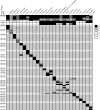Simple PCR-based DNA microarray system to identify human pathogenic fungi in skin
- PMID: 20421438
- PMCID: PMC2897498
- DOI: 10.1128/JCM.02185-09
Simple PCR-based DNA microarray system to identify human pathogenic fungi in skin
Abstract
Fungal diseases in immunocompromised hosts pose significant threats to their prognoses. An accurate diagnosis and identification of the fungal pathogens causing the infection are critical to determine the proper therapeutic interventions, but these are often not achieved, due to difficulties with isolation and morphological identification. In an effort to ultimately carry out the simultaneous detection of all human pathogenic microbes, we developed a simple system to identify 26 clinically important fungi by using a combination of PCR amplification and DNA microarray assay (designated PCR-DM), in which PCR-amplified DNA from the internal transcribed spacer region of the rRNA gene was hybridized to a DNA microarray fabricated with species-specific probes sets using the Bubble Jet technology. PCR-DM reliably identified all 26 reference strains; hence, we applied it to cases of onychomycosis, taking advantage of the accessibility of tissue from skin. PCR-DM detected fungal DNA and identified pathogens in 92% of 106 microscopy-confirmed onychomycosis specimens. In contrast, culture was successful for only 36 specimens (34%), 3 of which had results inconsistent with the results of PCR-DM, but sequence analysis of the isolates proved that the PCR-DM result was correct. Thus, PCR-DM provides a powerful method to identify pathogenic fungi with high sensitivity and speed directly from tissue specimens, and this concept could be applied to other fungal or nonfungal infectious human diseases in less accessible anatomical sites.
Figures


Similar articles
-
Rapid real-time diagnostic PCR for Trichophyton rubrum and Trichophyton mentagrophytes in patients with tinea unguium and tinea pedis using specific fluorescent probes.J Dermatol Sci. 2013 Mar;69(3):229-35. doi: 10.1016/j.jdermsci.2012.11.589. Epub 2012 Dec 5. J Dermatol Sci. 2013. PMID: 23287391
-
Forty-eight-hour diagnosis of onychomycosis with subtyping of Trichophyton rubrum strains.J Clin Microbiol. 2006 Apr;44(4):1419-27. doi: 10.1128/JCM.44.4.1419-1427.2006. J Clin Microbiol. 2006. PMID: 16597871 Free PMC article.
-
[DNA extraction and identification of Trichophyton rubrum by real-time polymerase chain reaction from direct nail scraping specimens of patients with onycomycosis].Mikrobiyol Bul. 2011 Jan;45(1):150-8. Mikrobiyol Bul. 2011. PMID: 21341169 Turkish.
-
Nails and fungi.Br J Dermatol. 1976 Jun;94(6):697-701. doi: 10.1111/j.1365-2133.1976.tb05171.x. Br J Dermatol. 1976. PMID: 132961 Review. No abstract available.
-
Onychomycosis: Which fungal species are involved? Experience of the Laboratory of Parasitology-Mycology of the Rabta Hospital of Tunis.J Mycol Med. 2018 Dec;28(4):651-654. doi: 10.1016/j.mycmed.2018.07.005. Epub 2018 Aug 11. J Mycol Med. 2018. PMID: 30107987 Review.
Cited by
-
Visual analysis of DNA microarray data for accurate molecular identification of non-albicans Candida isolates from patients with candidemia episodes.J Clin Microbiol. 2013 Nov;51(11):3826-9. doi: 10.1128/JCM.01050-13. Epub 2013 Jun 19. J Clin Microbiol. 2013. PMID: 23784121 Free PMC article.
-
Diagnosis of Dermatophytosis Using Molecular Biology.Mycopathologia. 2017 Feb;182(1-2):193-202. doi: 10.1007/s11046-016-0038-z. Epub 2016 Aug 1. Mycopathologia. 2017. PMID: 27480761 Review.
-
Solid and Suspension Microarrays for Microbial Diagnostics.Methods Microbiol. 2015;42:395-431. doi: 10.1016/bs.mim.2015.04.002. Epub 2015 May 14. Methods Microbiol. 2015. PMID: 38620236 Free PMC article.
-
Recent trends in molecular diagnostics of yeast infections: from PCR to NGS.FEMS Microbiol Rev. 2019 Sep 1;43(5):517-547. doi: 10.1093/femsre/fuz015. FEMS Microbiol Rev. 2019. PMID: 31158289 Free PMC article. Review.
-
Identification of fungal pathogens by visible microarray system in combination with isothermal gene amplification.Mycopathologia. 2014 Aug;178(1-2):11-26. doi: 10.1007/s11046-014-9756-2. Epub 2014 Jun 22. Mycopathologia. 2014. PMID: 24952715 Free PMC article.
References
-
- Arabatzis, M., L. E. Bruijnesteijn van Coppenraet, E. J. Kuijper, G. S. de Hoog, A. P. Lavrijsen, K. Templeton, E. M. van der Raaij-Helmer, A. Velegraki, Y. Graser, and R. C. Summerbell. 2007. Diagnosis of common dermatophyte infections by a novel multiplex real-time polymerase chain reaction detection/identification scheme. Br. J. Dermatol. 157:681-689. - PubMed
-
- Baek, S. C., H. J. Chae, D. Houh, D. G. Byun, and B. K. Cho. 1998. Detection and differentiation of causative fungi of onychomycosis using PCR amplification and restriction enzyme analysis. Int. J. Dermatol. 37:682-686. - PubMed
-
- Bryant, P. A., D. Venter, R. Robins-Browne, and N. Curtis. 2004. Chips with everything: DNA microarrays in infectious diseases. Lancet Infect. Dis. 4:100-111. - PubMed
Publication types
MeSH terms
Substances
LinkOut - more resources
Full Text Sources
Other Literature Sources
Research Materials

